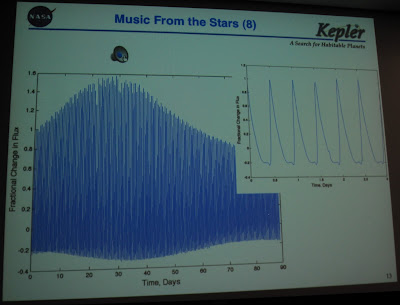We don't often get to experience stars or other celestial phenomena from an audio perspective, because we think of space as silent, but almost all objects in the universe produce sounds from whistling to humming through various frequencies, i.e. their natural speeds of vibration.

SETI scientist and Kepler Mission Co-Investigator Jon Jenkins hosted some of our groups at the NASA Ames Tweetup, and explained how his team detects transiting planets, including what they "sound" like:
The payoff comes around the 1:10 minute mark, where you actually hear the "buzz" of planet HATp-7b in the cosmos, oscillating at 8192 Hertz as it transits a star about 1,000 light years away from Earth.
Before the official start of science operations on the mission, data collected from this planet was used to demonstrate the high precision of measurements made by the Kepler telescope – even before completion of software testing and calibration!
Discovery of HATp-7b's brightness variations during occultation (when a planet passes behind a star) between transits proved that Kepler had the capability to find earth-size planets, and as we all know now from their recent findings, became even more precise! Who knew they would find so many in such a short time!

I skipped one of Jon's greatest hits in the music category, because it was such a monumentally unpleasant sound (think giant tubas played backward through an electric razor), and picked up with some of the more melodic selections, including a pulsating star:
Awesome stuff! Why would we go around listening for harmonic components from Quarter 1 light curves of variable stars? The entire Milky Way is also oscillating, and using astro-seismology, we can gather data about the properties of various regions by the pressure level of those oscillation frequencies... deducing things like age, size, formation, and future oncoming radio disruptions or geomagnetic storms.
(Because we sure aren't listening in for the catchy beat!)

For those of you who don't know Jon Jenkins, he has been a fun staple of SETI's YouTube Channel in terms of star analysis and measurement based on light fluctuation.
Such talents made him perfect for the Kepler team, where he led the design and implementation of the Science Operations Center Science Pipeline, which processes the pixel data from Kepler to detect signatures of transiting planets.
He's also a pretty cool, humble guy who seems a bit stunned that some geeky people such as myself actually know him on sight and could pick him out of a line-up!


































































